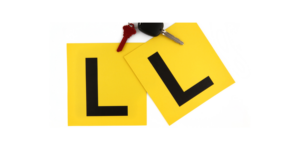What are the Rules for Learner Drivers in New South Wales?

Getting your driver licence is a huge milestone on the path to adulthood.
It provides a sense freedom and independence, but it also comes with responsibilities.
Driving also comes with risks and, sadly, statistics suggest that less experienced drivers who are under the age of 26 years are involved in almost 25% of fatal accidents despite making up only around 14% of all drivers.
For this reason, a number of rules have been implemented to keep both young drivers and other road users safe.
Not following these rules can amount to a traffic offence in New South Wales, potentially leading to hefty fines, demerit points and even licence suspension or disqualification and a long-lasting criminal conviction.
Here’s a rundown of the rules that apply to Learner Drivers in our state.
The rules that apply to L-Platers in New South Wales
Learner Drivers under the age of 25 are required to complete 120 hours of driving time, which must 20 hours of night driving.
In addition to this, all Learner Drivers must comply with the folllowing rules:
-
Supervision
Learners must have a supervisor present when driving – this person must hold a full Australian Driver’s Licence (it cannot be a P-plate holder) and sit in the passenger seat, next to the driver.
The maximum penalty for driving unsupervised is $2200 and a disqualification period of 12 months, with a minimum disqualification period of 3 months.
However, those who plead guilty can escape a conviction, licence disqualification and fine if the magistrate is persuaded to make a ‘non-conviction order’ such as a section 10 dismissal or conditional release order without conviction.
-
Correct use of an ‘L’ Plate
Drivers must let other other drivers and road users know that they’re new to the road, by displaying an “L” plate on the vehicle they’re driving. It must be attached in a way that is easily visible, so that other drivers can act accordingly around you on the road, aware that you’re not experienced.
-
Driving with passengers
Learners can drive with other passengers in the car, but they are responsible for ensuring that they are wearing a seatbelt and also that all passengers are wearing seatbelts, or are in child restraints. Animals travelling in the vehicle must also be restrained.
Breaking the rules relating to seatbelts currently comes with a penalty notice in in the sum of $352 and three demerit points, which can increase in school zones during school hours.
This penalty will rise if other passengers are not wearing seatbelts, or not are properly restrained. If an animal is not properly restrained the penalty is $362 and three demerit points.
-
Special speed limits apply
The maximum speed that Learners can drive at any time is 90 km/ph, even when the posted speed is higher, for example, on a motorway where the speed limit is 110 km/ph.
This is one of the reasons that an “L” plate must be used – to let other drivers know you’re on a learner license and subject to certain conditions, including speed limits.
Penalties for speeding offences in New South Wales can be harsh, so it’s important to remain under the limit regardless of whether other drivers may put pressure on you to speed up.
-
No mobile phones
Mobile phone use while driving is strictly prohibited for Learner drivers.
Mobile phone use is distracting, and driver distraction causes about 16% of road accidents each year.
Specific research shows that taking your eyes off the road for more than two seconds doubles your risk of crashing, and that handheld mobile phone use while driving is associated with at least a four‑fold increase in the risk of having a casualty crash.
Texting or fiddling around with music or map apps increases the crash risk even further.
Learner Drivers must not use a mobile phone while driving, at all, even if it functions via bluetooth. Learners must not use a phone when you’re stationary, for example, stopped at lights or stuck in traffic, or pulled over to the side of the road.
To use the phone, Learners must be parked safely and have the engine of the vehicle switched off.
This applies to all functions, including:
- texting,
- making or receiving phone calls,
- listening to music,
- emailing,
- using social media,
- using the internet,
- using maps and navigation,
- taking photos or videos, and
- watching videos or movies etc.
Learners should also be aware that they can fall foul of the law if a passenger is using a mobile device in such a way that the screen is visible to them while they are driving.
This applies to mobile phones that are handheld, in a phone holder or hands-free, for example, via Bluetooth, connected to the car’s display. The law also applies to any hands-free devices or loud speakers.
The penalty for breaking these rules is currently $344 and 3 demerit points. If you’re caught in a school zone, then it’s $457 and 4 demerits.
Drugs and Alcohol
Learners must have no drugs or alcohol in their system when they drive, this is called a zero point Blood Alcohol Concentration (BAC), which is the reading you get from a roadside breathalyzer. Anyone supervising a Learner Driver must have less than 0.5 BAC, and no drugs detected in their system.
Learners are also required to have no drugs in their system. However, drug detection is more complex and a person does not have to be impaired by drugs to be charged with a drug driving offence – simply having traces of a drug present in your system is enough to support a charge.
If you are a Learner and you have failed a police roadside drug test and are facing drug driving charges, seek the help of a professional lawyer as soon as possible.
Towing
Learner drivers are strictly prohibited from towing another vehicle for example, a boat, or a caravan or a trailer.
NSW Transport recommends that anyone wanting to tow another vehicle regularly should undertake Tow-Ed, a one-day course which focuses on skills and tips so that drivers learn correctly how to be in control of two vehicles simultaneously without compromising safety.
Demerit points for Learner Drivers
Learner Drivers are allowed to allocate a maximum of 4 demerit points over a 3 year period in New South Wales.
Accruing any more points then this will lead to a licence suspension of 3 months, which means you will not be able to drive until the suspension expires.
Driver licence appeals in NSW
A person who is issued with a penalty notice or given a driver licence suspension can appeal this to a Local court, where the magistrate will decide how to deal with the matter.
If you dispute that the offence occurred, this can be challenged during what is known as a defended hearing, where any witnesses such as police and/or anyone who was in your car or otherwise observed the events can attend and testify before the court, after which the magistrate will decide whether you are guilty or not guilty.
If you accept what occurred and wish to plead guilty, and depending on the traffic offence or offences involved, the magistrate may:
- confirm any suspension,
- reduce the period of any suspension,
- confirm or even increase any fine that was issued up to a maximum of $2,200, or
- deal with the matter by way of a non-conviction order such as a section 10(1)(a) dismissal or conditional release order without conviction, in which case there will be no conviction, no suspension, no fine and no demerit points.
Going to court for a driving-related case?
If you have been given a court attendance notice for a traffic matter, call Sydney Criminal Lawyers anytime on (02) 9261 8881 and let our expert traffic lawyers review your case, advise you of your options and best way forward, and work towards the best possible outcome.







